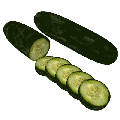 . . . about Carbon Dioxide in the atmosphere, that is.
. . . about Carbon Dioxide in the atmosphere, that is.
In April, the Supreme Court of the United States (SCOTUS) ruled that the Environmental Pollution Agency must consider Carbon Dioxide (CO2) as an air pollutant!
Now, as you may know, the gas CO2, is critical to the growth of vegetation on our planet; plants ‘breathe CO2 and exhale oxygen’ as it were. Animals, including us, do exactly the opposite – breathe oxygen and exhale CO2. You know what happens when animals are deprived of oxygen, so you must have a clue what might happen to CO2-deprived vegetation.
The current editorial at CO2 Science addresses that scenario – that is, an actual scientific experiment that documents what happens when cucumbers are deprived of CO2 (The following has been excerpted from “Carbon Dioxide: A Vital Atmospheric Resource Under Siege“):
Based on our visual inspection of Klaring et al.’s graphs of hourly atmospheric CO2 concentrations within a greenhouse treated in this manner and within another greenhouse where the CO2 removed by the photosynthesizing cucumber plants was not replenished, we calculate that over the daylight periods of two separate experiments they conducted, there was a mean daytime reduction of approximately 110 ppm (from approximately 395 ppm to about 285 ppm) in the greenhouse-air CO2 concentration caused by the growth of the plants in the non-CO2-replenished greenhouse. And this reduction in the air’s CO2 concentration, according to what they report, led to a 28% decrease in cucumber fruit yield, which is the same percentage by which the greenhouse air’s CO2 concentration was reduced by the photosynthesizing cucumber plants in the control or non-CO2-replenished greenhouse.
Now the partial removal of an atmospheric pollutant from the air would be expected to have a positive impact on important plant processes; but in the case of the perceptive cucumbers (which could not be fooled), just the opposite was observed: letting the cucumbers partially remove from the air what some people want to call a pollutant (CO2) and not replacing it actually harmed the cucumbers, by significantly reducing their productivity. Thinking of this experiment in reverse leads to the same conclusion: the 38% increase in the CO2-replenished greenhouse air’s CO2 concentration significantly boosted cucumber fruit yield (by a similar 38%), which is not what an air pollutant does, but what an aerial fertilizer does.
